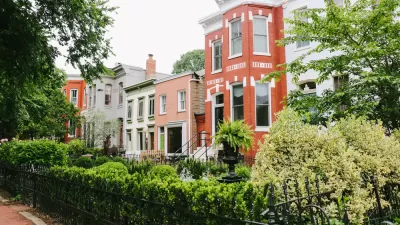The 1910 law, responsible for preserving views of the capitol from most roof decks, is being challenged by a small group of architects and developers who believe a modest change would inject vitality, sustainability and revenue into the urban fabric.
Preservationists view any alteration to the height limit will only open the door to more development. "I don't think you get it - it's a very special place," said Ann Hargrove, a resident and ardent defender of the limit. "Our capital was designed in such a special way to be different. One great feature is its height." She admitted that new buildings do get boxy, but said profit-minded developers, if left unchecked, would destroy the graceful parts of Washington's skyline.
Shalom Baranes, a Washington-based architect who wrote two articles this year promoting changes, argued that a modest relaxation in areas outside downtown would allow for a more modern city with greener construction, what developers sometimes refer to as "smart growth."
Dorn C. McGrath Jr., professor emeritus of city and regional planning at George Washington University, and a supporter of the limit, recolonized the need to evolve, but said that just because developers called growth smart did not mean it was.
FULL STORY: In The Capital, Rethinking Old Limits On Buildings

Planetizen Federal Action Tracker
A weekly monitor of how Trump’s orders and actions are impacting planners and planning in America.

Map: Where Senate Republicans Want to Sell Your Public Lands
For public land advocates, the Senate Republicans’ proposal to sell millions of acres of public land in the West is “the biggest fight of their careers.”

Restaurant Patios Were a Pandemic Win — Why Were They so Hard to Keep?
Social distancing requirements and changes in travel patterns prompted cities to pilot new uses for street and sidewalk space. Then it got complicated.

Platform Pilsner: Vancouver Transit Agency Releases... a Beer?
TransLink will receive a portion of every sale of the four-pack.

Toronto Weighs Cheaper Transit, Parking Hikes for Major Events
Special event rates would take effect during large festivals, sports games and concerts to ‘discourage driving, manage congestion and free up space for transit.”

Berlin to Consider Car-Free Zone Larger Than Manhattan
The area bound by the 22-mile Ringbahn would still allow 12 uses of a private automobile per year per person, and several other exemptions.
Urban Design for Planners 1: Software Tools
This six-course series explores essential urban design concepts using open source software and equips planners with the tools they need to participate fully in the urban design process.
Planning for Universal Design
Learn the tools for implementing Universal Design in planning regulations.
Heyer Gruel & Associates PA
JM Goldson LLC
Custer County Colorado
City of Camden Redevelopment Agency
City of Astoria
Transportation Research & Education Center (TREC) at Portland State University
Camden Redevelopment Agency
City of Claremont
Municipality of Princeton (NJ)





























